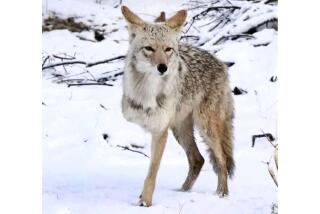The science of the Mojave, and scorpions that glow in the dark
Darkness cloaked the desert, pierced only by a canopy of stars that provided a glittering backdrop for 20 college students treading cautiously over the cracked, dry landscape. But a soft hiss stopped them in their tracks.
Mudassar Haq heard the rattlesnake and shouted to alert the others as classmate Thomas Parker shined a flashlight on a large sidewinder slithering away under a tuft of salt grass.
“I immediately knew what it was, that’s something you don’t think twice about,” said Haq, 20, a Cal State Fullerton junior. “My instinct was to run.”
But neither student did. Their calm response allowed for an unexpectedly close look at a staple of the Mojave and Sonoran deserts. “This is an unusual treat,” Fullerton associate biology professor William Hoese told the group. “We’re going to give it room.”
The biology students were spending a recent weekend with 40 classmates and two professors at Cal State’s Desert Studies Center, a 1,200-acre field station in the Mojave that is one of the world’s few desert research facilities.
The center, 60 miles east of Barstow near Soda Springs, has a colorful past as a 1940s-era health spa founded by Curtis Howe Springer, a radio evangelist. Springer built dormitories, created mineral baths in the shape of a cross and sold potions he claimed would cure everything from hair loss to cancer.
He named the resort Zzyzx, so it would be “the last word in health,” as he put it. But he had set up his business on federal land without authorization and it was confiscated in 1974, although the sign for Zzyzx Road between Los Angeles and Las Vegas still puzzles motorists on Interstate 15. A man-made oasis, the site is now part of the 1.6-million-acre federally owned Mojave National Preserve.
The Cal State facility is run by a consortium of seven campuses and managed mainly by Cal State Fullerton. About 2,300 people visit annually, including day-trippers and those planning multi-night stays. For a $16 nightly fee ($8 for Cal State students and staff), guests can use the center’s library, lab, Internet access, cots and hot showers.
Some expenses at the center have been trimmed because of state funding cuts but overall operations have not been threatened, said its director, Cal State Fullerton professor William Presch. This year, it received $56,000 for operations from the Cal State system and another $50,000 in fees that pay for major equipment and upkeep. The center will soon install a 40-kilowatt solar plant that will power most of the facility.
The National Park Service owns and maintains many of the older buildings and submitted Zzyzx, its original buildings, landscaping and other features for National Historic Registry status. A lake on the property is home to the Mohave tui chub, an endangered fish once thought to be extinct.
The center attracts researchers from around the world to study geology, climatology, astronomy and other fields and it has been used in feature films and documentaries. NASA uses it as a base camp for its Spaceward Bound program, which trains students and teachers to live and work in harsh environments that mimic surfaces of the moon and Mars.
It’s also a place where Cal State and other students learn firsthand about desert plants and animals, and where many have a first encounter with the natural world in an unforgiving environment.
“It’s a big thing for them to think they might not shower for a night,” said Fullerton associate professor Danielle Zacherl, who brought 240 members of her introductory biology class to the center over two recent weekends. “Being in the desert is a physical and cultural challenge.”
That point was emphasized by site steward Jason Wallace, who briefed the students on a few basics: The nearby springs attract bighorn sheep, foxes and other desert creatures; leave a door or window open and you can expect some interesting visitors come morning.
Some students had no trouble acknowledging they were out of their element and occasionally uncomfortable, on a weekend when the temperature topped 112 degrees.
“I don’t like bugs, I stay away from them,” said Sweta Babaria, 17, a biology major who is interested in marine life and had to be coaxed to get close to a fluttering dragonfly and other insects during one lesson. “I hate the wilderness. I’m a germ-freak. But I had to come, otherwise I’d fail the class.”
After dark, the students set out over the flat, sandy plain with ultraviolet lights to search for scorpions, whose exoskeletons contain a chemical that makes them fluorescent under the black light. About a half mile out, they could be found lurking in the underbrush, an ethereal, prehistoric presence.
“The scorpions, that was kind of cool,” said biology major Chelsy Bognot, 18, who said the weekend was better than she anticipated. “I’ve been dirt bike riding near Barstow but I’ve never experienced anything like this. You have an understanding that there’s more out here than just shrubs and snakes. There’s a lot more life, a food chain.”
In the morning, the students rose early for a drive to the foothills of the Soda Mountains to see the Mojave’s plant life — creosote bushes, honey mesquite trees, cactus and other species — and watch lizards sunbathing on the red, yellow and black rock beds.
Rudy Macias worked his way up the hills taking notes.
“Being in the desert is something I’ll probably never do again, unless it’s Las Vegas,” Macias, 21, a health science major, said jokingly. “But it’s neat. Grabbing bugs and looking for scorpions, it’s like being a boy again.”
More to Read
Start your day right
Sign up for Essential California for news, features and recommendations from the L.A. Times and beyond in your inbox six days a week.
You may occasionally receive promotional content from the Los Angeles Times.






